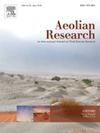塔克拉玛干沙漠腹地次生沙丘密度的估算
IF 3.4
3区 地球科学
Q2 GEOGRAPHY, PHYSICAL
引用次数: 0
摘要
次生沙丘密度是研究沙漠地表特征和监测沙脊发育的重要参数。它为描述区域次生沙丘的分布提供了一种有效的手段。然而,目前还没有有效的沙丘密度估算方法,特别是对于依附于大型沙脊的次级沙丘,由于其规模较小,往往被忽视。因此,本研究提出了一种更有效的利用谷歌地球影像和YOLOv8s算法估算次生沙丘密度的方法。本研究利用塔克拉玛干沙漠腹地的谷歌地球影像,构建了二次沙丘识别数据集。在此基础上,对二次沙丘识别模型进行训练和验证,以估计二次沙丘密度。研究结果表明,该模型识别次生沙丘的平均精度(AP50)为63.58%,优于其他基准算法。此外,该沙丘识别模型成功识别了验证区内共18208个次生沙丘。该模型对塔克拉玛干沙漠腹地次生沙丘密度具有较高的预测能力,预测值与实测值的决定系数(R2)为0.89。平均绝对误差(MAE)为20.94 km−2,均方根误差(RMSE)为25.04 km−2。至关重要的是,二次密度估计的准确性高度依赖于从图像中精确描绘沙丘轮廓、峰顶线、沙丘弧和山脊线。本文提出的次生沙丘密度估算方法克服了现有研究的局限性,为研究风成沙丘的演化过程提供了新的思路。本文章由计算机程序翻译,如有差异,请以英文原文为准。
Estimation of secondary dune density in the hinterland of the Taklimakan Desert
The secondary dune density is a crucial parameter for studying desert surface characteristics and monitoring the development of sand ridges. It provides an effective means to describe the distribution of regional secondary dunes. However, there is currently no effective method for estimating dune density, particularly for secondary dunes that are attached to large sand ridges, which are often overlooked due to their smaller scale. Therefore, this study presents a more effective method for estimating secondary dune density by utilizing Google Earth images and the YOLOv8s algorithm. This study utilizes Google Earth images from the hinterland of the Taklimakan Desert to construct a secondary dune identification dataset. Based on the dataset, we train and validate the secondary dune identification model to estimate secondary dune density. The research results indicate that the model achieved an average precision (AP50) of 63.58 % for secondary dune identification, outperforming other baseline algorithms. Furthermore, the dune identification model successfully identified a total of 18,208 secondary dunes within the verification area. The model demonstrated a higher predictive capability for secondary dune densities in the Taklimakan Desert hinterland, with a coefficient of determination (R2) of 0.89 between estimated and observed values. The mean absolute error (MAE) was 20.94 km−2, and the root mean square error (RMSE) was 25.04 km−2. Crucially, the accuracy of the secondary density estimation is highly dependent on the precise delineation of dune outlines, crest lines, dune arcs, and ridge lines from the imagery. The method for estimating secondary dune density proposed in this study overcomes the limitations of existing research and provides new insights into the evolutionary processes of aeolian dunes.
求助全文
通过发布文献求助,成功后即可免费获取论文全文。
去求助
来源期刊

Aeolian Research
GEOGRAPHY, PHYSICAL-
CiteScore
7.10
自引率
6.10%
发文量
43
审稿时长
>12 weeks
期刊介绍:
The scope of Aeolian Research includes the following topics:
• Fundamental Aeolian processes, including sand and dust entrainment, transport and deposition of sediment
• Modeling and field studies of Aeolian processes
• Instrumentation/measurement in the field and lab
• Practical applications including environmental impacts and erosion control
• Aeolian landforms, geomorphology and paleoenvironments
• Dust-atmosphere/cloud interactions.
 求助内容:
求助内容: 应助结果提醒方式:
应助结果提醒方式:


